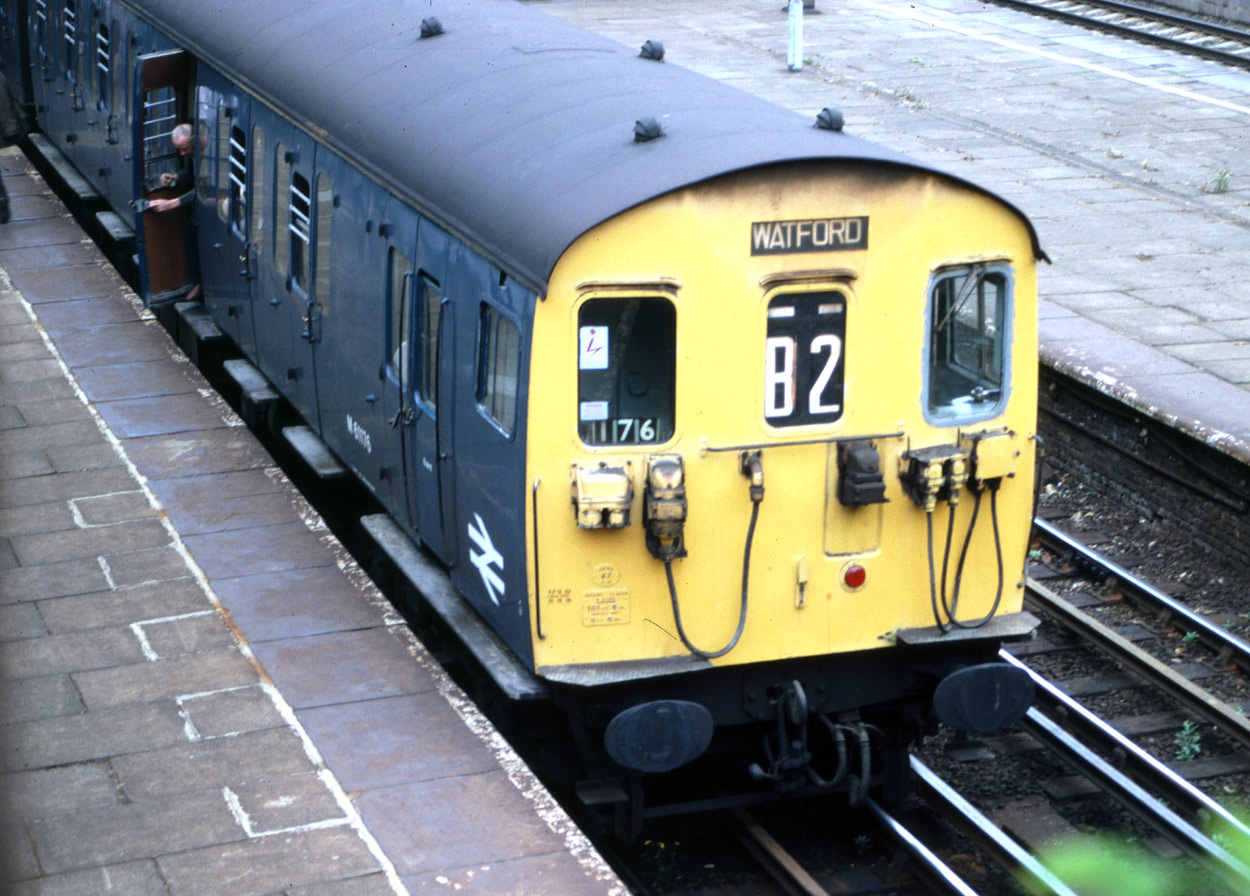- British Rail Class 501
Infobox EMU
name = British Rail Class 501
imagesize = 300px
caption = A northbound Class 501 train calls at Harrow and Wealdstone. The B2 headcode signifies that this train worked the Broad Street-Watford via Primrose Hill (and vice versa) service.
background = #012545
Manufacturer =British Railways
Operator =British Rail
Formation = power car + trailer + driving trailer
Built = 57 trainsets
InService = 1957-1985
Weight = Total - 106 tonnes
CarLength = convert|57|ft|mm|abbr=on
CarWidth = convert|9|ft|6|in|mm|abbr=on
CarHeight = convert|12|ft|8|in|mm|abbr=on
Capacity =
MaxSpeed = convert|60|mph|km/h|abbr=on
Power = 4 x 185 hp traction motors
total 740 hp (552 kW}
Gauge =standard gauge
Voltage = 630 V DC third and fourth railThe British Rail Class 501
electric multiple unit s were built in 1957-1958 for use on the former LNWR / LMS suburban electric network of theLondon Midland Region . A total of 57 three-car units were built.ervices
The services worked by the Class 501 units consisted of a small self contained group of lines, which were electrified at 650 V DC on the 3rd and 4th rail principle, linking London Euston to
Watford , Broad Street with both Richmond andWatford plus the Croxley Green branch - which was mostly served by shuttle trains fromWatford . Some of these services were partially jointly operated withLondon Underground 's Bakerloo and District Lines. In 1970, the trains were converted to 3rd rail only operation, although the 4th rail was retained on sections of line which are shared with London Underground trains.Description
The Class 501 units were built by
British Railways in its own workshops at Eastleigh on short 57 ft frames supplied by Ashford.Despite British Railways having recently built modern sliding door trains for electric suburban services in
Manchester andLiverpool it was decided that these trains would closely resemble the EPB stock of the Southern Region, which featured individual passenger operated doors located at each seating bay. To prevent passengers leaning out of the opening windows they were partially blocked with three bars - this was for passenger's safety when travelling through areas with limited clearance, especially Hampstead Tunnel. This earned them the nickname "Jail units".The trains were made up in 3-car formations as follows:Driving motor with two saloons of 3+4 bays + 9 compartment intermediate trailer + driving trailer with two saloons of 3+4 bays. Unusually for the time, the vehicles featured screw couplings both within and between the units, in contrast to the SR units which had intermediate single buffer and chain and buckeye couplings at the unit ends. The motor coaches had two powered bogies and GEC electrical equipment. They were the first to have camshaft controllers.
The train ends also followed the EPB style and incorporated a two character alpha numerical headcode.
Initially these trains were painted in the standard mid-green livery adopted for electric multiple unit stock at nationalisation. This was replaced by a dark brunswick green livery with wide yellow bands in the early 1960s, the same livery as had been adopted for diesel multiple unit stock. In the late 1960s, this was changed to rail blue. In 1980, some trains were partially modernised, a process which included seeing them being repainted in the blue/grey livery. Due to vandalism, the intermediate trailer cars were modified from compartment layout to open saloon. This work was carried out at Croxley Green workshops and though quite neatly done, the overhead luggage racks which had been attached to the partitions were not replaced, leaving nowhere to put things like coats and umbrellas.
The trains were allocated to
Croxley Green depot and withdrawn from operation in May 1985. The trains on the east-west orbital service which by then operated between North Woolwich station and Richmond station were replaced with Class 416 units from the Southern Region. Services between London Euston / Broad Street andWatford and on the (former) Croxley Green branch were replaced by sliding door Class 313 units.Numbering
British Railways numbers were:
* Motor Open Brake Second, M61133-M61189
* Trailer Open Second, M70133-M70189
* Driving Trailer Open Brake Second, M75133-M75189Further use
* 10 Class 501 DMBS carriages were converted to Class 97/7 battery locomotives.
* Two carriages, DTS 75186 and TS 70170 went on to work at MOD Marchwood.
* Three two-car units were converted to Class 936 sandite units, and saw use until the early 2000s.Preservation
Currently, two vehicle has been preserved. The two carriages used by the MOD were put up for disposal in early 2006. The driving trailer, no. 75186, was saved for preservation and has moved to the
Coventry Railway Centre . It was joined by driving motor no. 61183 in October 2006, and it is hoped that the centre trailer coach will also eventually be preserved.Sources
* Ian Allan ABC of British Railways Locomotives, winter 1962/3 edition, page 325
External links
* [http://www.therailwaycentre.com/Pages%20EMU/Recognition%20EMU/IllusEMU_501.html The Railway Centre]
* [http://www.emus.co.uk/ The Suburban Electric Railway Association]
Wikimedia Foundation. 2010.
